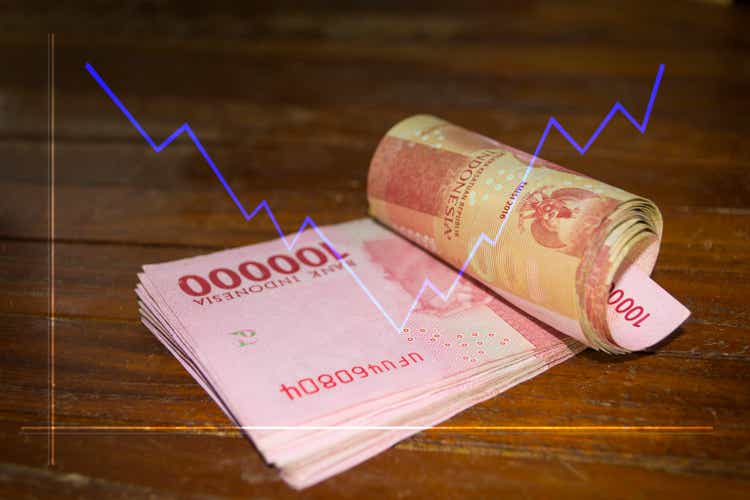iyuyu photo/iStock via Getty Images
By Prashant Singh
Indonesia’s labor reforms and its move up the mineral exports value chain will drive structural improvement in its external accounts.
Indonesia is a resource-rich country closely tied to the commodity cycle. It was hit by a major terms-of-trade shock after 2011 as the end of a decade-long commodity “super-cycle” led to a sizable drop in the value of Indonesia’s commodity exports, significantly worsening the country’s external account. However, some recent developments have the potential to meaningfully change this dynamic. First, the recent passage of labor reforms should lead to stronger inward investments into the country. Second, and more importantly, the government’s policy of transitioning to exporting downstream commodity products is starting to bear fruit, setting Indonesia up for structural improvements in the current account.
The two issues are intrinsically linked. Since President Joko “Jokowi” Widodo was elected in 2014, his industrial policy was to move up the value chain through import substitution and “downstreaming” of exports. It saw mixed success in the early years, due to inconsistency in regulations and a protectionist environment. However, a continued push for reforms culminating in the enactment of the Omnibus law in 2020 has helped address bottlenecks that historically weighed on foreign investments and re-industrialization. Changes include reductions in severance payments, making it easier to employ foreign workers, and lifting of foreign ownership ceilings. All these have provided a much-needed boost to investments in the commodity sector.
The results are beginning to show. Indonesia’s metals export growth volume rose more than 40% year-over-year in 2021. The trade deficit with China fell from $17 billion in 2019 to around $2 billion in 2021, led by reduced steel imports. Iron and steel exports are projected to rise 80% – 90% in the coming two to three years, equivalent to another 2% of GDP. The current nickel downstream development has focused on stainless steel, but Indonesia also plans to become a major player in the global electronic vehicle supply chain by utilizing its ample nickel reserves. New facilities focusing on green energy will be the next driver of downstream industrialization. All this should not only bring the Indonesian current account back to a sustained surplus but, coupled with a resilient and improving FDI pipeline, make its basic balance profile look very healthy indeed.
These developments should lead to a further reduction in risk premia associated with Indonesian assets, and result in ratings upgrades and structurally lower yields in the years ahead. We now hold a more constructive medium-term outlook on Indonesia, though meaningful outperformance will likely have to wait until the external environment becomes more conducive for emerging market assets.
This material is provided for informational purposes only and nothing herein constitutes investment, legal, accounting or tax advice. This material is general in nature and is not directed to any category of investors and should not be regarded as individualized, a recommendation, investment advice or a suggestion to engage in or refrain from any investment-related course of action. Investment decisions and the appropriateness of this material should be made based on an investor’s individual objectives and circumstances and in consultation with his or her advisors. Information is obtained from sources deemed reliable, but there is no representation or warranty as to its accuracy, completeness or reliability. All information is current as of the date of this material and is subject to change without notice. The firm, its employees and advisory accounts may hold positions of any companies discussed. Any views or opinions expressed may not reflect those of the firm as a whole. Neuberger Berman products and services may not be available in all jurisdictions or to all client types. This material may include estimates, outlooks, projections and other “forward-looking statements.” Due to a variety of factors, actual events or market behavior may differ significantly from any views expressed.
Investing entails risks, including possible loss of principal. Investments in hedge funds and private equity are speculative and involve a higher degree of risk than more traditional investments. Investments in hedge funds and private equity are intended for sophisticated investors only. Indexes are unmanaged and are not available for direct investment. Past performance is no guarantee of future results.
This material is being issued on a limited basis through various global subsidiaries and affiliates of Neuberger Berman Group LLC. Please visit www.nb.com/disclosure-global-communications for the specific entities and jurisdictional limitations and restrictions.
The “Neuberger Berman” name and logo are registered service marks of Neuberger Berman Group LLC.
© 2009-2022 Neuberger Berman Group LLC. All rights reserved.
Editor’s Note: The summary bullets for this article were chosen by Seeking Alpha editors.


Be the first to comment